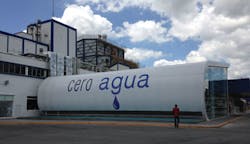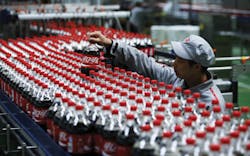H2O Risk: Business [not] as Usual
Water risks are now a major concern for multinationals. Nestlé realised this nearly 10 years ago and made changes. How are other companies pre-empting what could be industry's biggest challenge?
by Prof. Asit. K. Biswas
During the Industrial Revolution, most of the manufacturing factories were located near rivers and canals. This meant that water availability was plentiful, wastes could be discharged to the water bodies mostly without any treatment, and waterways could be used to transport raw materials to the plants and then ship out manufactured outputs.
As urbanisation progressed and industrial activities increased, rivers like the Thames in England became progressively heavily contaminated with domestic and industrial wastes, so much so that over time, aquatic life was decimated. In fact, by 1858, the stench from the sewage was so bad that the Parliamentary sittings of the House of Commons had to be suspended, and this period is now referred to as the "Great Stink."
Prime Minister Benjamin Disraeli had to rush through an Act which provided necessary funds so that a large network of interceptor sewers could be constructed to collect the wastewaters from the outfalls. By 1874, this system was operational and carried wastes far beyond the city's edge, but still untreated.
For the most part of the 20th century, industrial enterprises generally did not consider the availability of good quality water or proper wastewater treatment to be important business consideration.
By the beginning of the 21st century, with increasingly higher global population, rapid urbanisation, and even higher levels of industrial and other human activities, along with poor water management practices in nearly most countries of the world, water increasingly became a scarce commodity and water quality steadily became a serious global concern.
At present, nearly all water bodies within and near urban centres in the developing world are getting progressively more and more contaminated with known and unknown pollutants. Such developments are not only contributing to serious health and environmental hazards but also posing serious risks to long-term survival of industries.
The problem of declining groundwater levels has been further aggravated by prolonged droughts in recent decades in many countries of the world, including Australia, Brazil, China, India and USA. During such drought periods, groundwater use increases significantly to sustain various human activities, especially agriculture. This intensive abstraction of groundwater is ensuring that even when the droughts are over, the recharge rates will not be high enough so that groundwater levels could gradually return to their pre-drought levels. For example, it has been estimated that the extra cost of pumping alone during the current drought in California will exceed $500 million.
No industry can survive without water. Equally, many of the inputs they obtain from their suppliers cannot be manufactured or grown without water. At present only a few major multinational corporations (MNCs) have carefully assessed both the risks that water poses for their own factories as well as to their input suppliers.
They are rapidly realising that for their own future survival, existing business as usual water and wastewater management practices cannot continue much longer.
Industrial Water
By the beginning of the 21st century, a few of the most perceptive and forward-looking CEOs of major multinational companies that depend heavily on water became aware that water availability is increasingly becoming a serious business risk.
Not surprisingly, over the last decade, more and more of the world's largest 500 companies have started to assess their water availability as a business risk. They are somewhat belatedly realising that poor water and wastewater management practices could pose significant losses in terms of their global reputation, credibility and to the bottom lines.
Many of the Global 500 companies have started to report their potential water risks in annual reports. However, most of these risk assessments still are not considering the water demands of the local communities from where either they and/or their input suppliers source water. Several major corporations have found out to their annoyance that they simply cannot afford any longer to ignore the water needs of the local communities from where they obtain their water, especially during drought years.
The increasing realisation of the business community to water and wastewater management is manifested in the Global Risk Report 2015 of the World Economic Forum (WEF). This annual report assesses the perceptions of the major global risks over the medium timeframe of the next 18 months to 10 years. For the preparation of the 2015 report, the opinions of some 13,000 executives in 144 economies were surveyed between February and May 2014.
The most noteworthy part of the WEF report is that for the first time in ten years, the respondents identified a non-financial issue, water, as the most important global risk in terms of overall impacts. Fiscal crisis was the number eight global risk. The emphasis of the WEF report on water is not surprising.
Nestle' Nails it
Very few major companies have taken water and wastewater management as seriously as Nestlé. In 2005, Peter Brabeck-Letmathe, who was then its CEO, organised a breakfast discussion during the annual meeting of the World Economic Forum, in Davos, focusing on the world around water.
Based on the results of this discussion and further personal reflections, in 2006, during the Nestlé's 140th anniversary, Brabeck and Nestlé concluded that if Nestlé had to survive and thrive for the next 140 years, the most important resource they need to look after is water. Since then, Nestlé has very successfully institutionalised the importance of efficient water and wastewater management within its corporate culture.
The results have been spectacular. Over the past 10 years, Nestlé has progressively reduced its water requirements per dollar of sale by over 65%. The company is also one of the world's largest milk processors. In 2015, it will have two milk factories in India and Mexico, which will collect and condense all the water during the milk evaporation process.
With this new source of water, which earlier simply evaporated into the atmosphere, these two factories will actually become water positive, that is, instead of withdrawing water from the environment, they will add water to the environment. This is likely to be the pattern for all Nestlé milk processing plants throughout the world in the coming years.
Peter Brabeck is now one of the world's most important leaders who is championing efficient and equitable water use by business, government and civil society. Many other business leaders are following Brabeck's footsteps to improve water management practices and processes within their companies and also their input suppliers.
China's Water Woes
Unfortunately, the governments of most countries have not been as proactive and responsive to promote good and efficient water management as the business sector has done during the post-2000 period.
All over the world, water resources are under stress because of decades, even centuries of mismanagement. For example, take China. The Government has estimated during the 1990s that the country had some 50,000 rivers whose catchment areas exceeded 100 km2.
By the end of 2011, this number had been dramatically reduced to 22,909. This means no more than half of the rivers had disappeared in less than two decades. Among the main reasons for these disappearing rivers are the declining groundwater and river flow levels due to continually increasing water withdrawals for urban and industrial uses, widespread deforestation and continuation of poor water and land use practices.
It is not only water quantity that has become a problem in China but also water quality. Poor wastewater management practices over decades by its urban centres and industries have ensured that water quality in much of the country has progressively deteriorated. In 2014, the Government reported after testing groundwater in 203 cities, that around 18% were "very poor" which meant they could no longer be considered as possible sources for drinking water. Some 44% were classified as "relatively poor," which indicated these could be used for drinking only after proper treatment.
In 2013, the Chinese Government reported that groundwater some 400,000 km2 of North China Plain was so contaminated that they were unfit for any type of human contact. This is a serious issue since nearly one-third of water used in China comes from groundwater. Only 3% of groundwater in urban areas can now be considered as "clean".
Indiscriminate discharges of domestic and industrial wastewaters without proper treatment have contributed to widespread health and environmental hazards. In 2013, the Chinese Government publicly admitted the presence of "cancer villages" along stretches of Huaihe River. The Chinese Centre for Disease Control and Prevention reported that in the worst stretch, the lung cancer mortality for women, between 1973 and 2005, had increased 20-fold. The main culprits were factories producing leather, paper and plastics which discharged their untreated wastewater to the rivers and its tributaries.
In 2014, the Chinese environment ministry finally released data which indicted that at least 20% of the country's arable land is polluted with hazardous materials like cadmium, arsenic and lead. Official estimates indicate that at least 12 million tonnes of grains are contaminated each year with toxic chemicals. Until 2013, issues like cancer villages and soil contamination were considered to be State secrets. China's new leadership is now making pollution issues more transparent, even though the officials of various ministries knew of their existence for at least a decade.
While China's breakneck economic growth has intensified its water and wastewater management problems, the general direction of water and wastewater management problems in most other major developing countries like India, Brazil, Mexico or South Africa are somewhat similar.
Water Management Crisis
As water is becoming increasingly scarce, polluted, over-exploited, mismanaged and misallocated, business leaders are realising that it could seriously disrupt their operations in the coming years. At the very least, business costs may increase because of scarcity of appropriate quantity and quality of water, higher water prices and increasing compliance requirements for wastewaters.
Scarcity has already resulted in conflicts between local communities and businesses that are heavy water consumers. For example, in 2013, Barrick Gold suspended its Pascua Lama mine, straddling Chile-Argentina border, following a court injunction filed by the indigenous communities of Chile because of potential groundwater contamination. This stoppage came after an investment of $5 billion.
Rio Tinto had to abandon its Pebble Mine copper and gold project in Alaska because of potential adverse impacts to salmon fisheries, necessitating a $300 million write-off. The company subsequently donated its 19.1% stake in the mine to two Alaskan charities. Similarly, BHP Biliton had to invest $2.2 billion for a desalination plant for its Escondida copper mine in Chile.
In general, for the mining industry in most parts of the world, the availability of water and proper treatment of wastewater are two most important considerations. Not surprisingly, at present, nearly 100% of mining, pharmaceutical, electronics and computer, oil and gas and food and beverages companies that belong to the world's 250 largest corporations already report water risks in their annual reports.
All my research indicates that the world is not facing a water crisis because of its physical scarcity. The world has enough water not only to provide for all the human needs for the existing 7.3 billion people, but also for the needs of an estimated 9.6 billion people by 2050, with better standards of living. We already have adequate knowledge, technology and management expertise to achieve these goals.
However, the world is facing a serious water management crisis. Unless water management practices and processes can be very significantly improved within the next one to two decades, many parts of the world will face crises that will be unprecedented in human history.
One can only hope that the world will be wiser and prove centuries-old Scottish proverb which says "we never know the worth of water till the well is dry" to be wrong in the coming decades.
Asit K. Biswas is a Distinguished Visiting Professor Lee Kuan Yew School of Public Policy, Singapore. Acknowledged as one of the world's leading authorities on water, he has advised 19 governments and founded the Third World Centre for Water Management.
More Water & WasteWater International Archives Issue Articles



